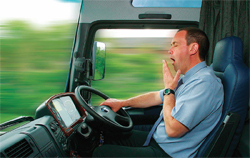
By Andy Stewart
A new guide has been put together to help inform truck drivers of the dangers of sleep apnoea and answer the most commonly asked questions about the condition.
Called Sleep Apnoea and Driving – The Facts, the document has been written to demystify Obstructive Sleep Apnoea Syndrome (OSAS) – a condition particularly prevalent among HGV drivers and thought to be a contributing factor in a significant percentage of motorway traffic accidents.
The document, developed following collaboration between the OSA Partnership Group and DVLA, has taken into account input from clinicians and the haulage industry.
Professor John Stradling from the Oxford Sleep Clinic played a prominent role in agreeing the wording. He said: “It is vital we do not push the problem underground by making it difficult for commercial drivers to admit they have symptoms. Therefore, members of the OSA Partnership Group have worked closely with the DVLA to agree a consistent process that highlights the importance and the longer term benefits of seeking treatment quickly.”
Experts said those most at risk of having the condition are overweight middle-aged men – and due to the sedentary nature of their job, HGV drivers are at higher risk of OSAS. However, OSAS can be fully treated quickly and easily; and when the symptoms are controlled, quality of life can improve considerably. However, if left untreated, OSAS is likely to impact on overall health and wellbeing, and can impact on life expectancy.
Ian Gallagher, head of policy for DVLA Policy at FTA, which is a member of the Group, said: “We understand from talking to our members that many drivers have concerns about seeking medical advice for fear of losing their licence. However, this document provides answers to many questions about OSAS and also offers advice on how to access treatment quickly as possible.”
The OSA Partnership Group has been established to bring together organisations from the commercial vehicle sector, clinicians, patient groups and those interested in health and safety at work to raise awareness of sleep apnoea and address the road safety issues associated with the condition.
The document can be accessed at http://tinyurl.com/np7n8nj






